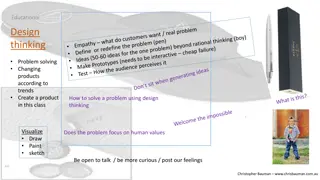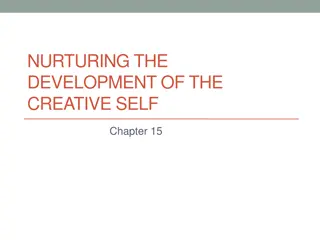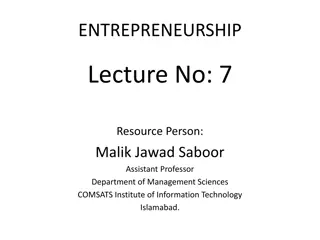Exploring Creativity and Collaboration in Online Learning
Dive into the world of creativity and collaboration in online learning through this insightful session. Learn how to create interaction for group work, address collaboration challenges, and inject creativity into learner engagement. Gain a deep understanding of what creativity entails and discover how online learners approach their educational journey. Engage in stretching exercises to enhance individual learning experiences and explore the Persona Exercise for a self-discovery journey.
Download Presentation

Please find below an Image/Link to download the presentation.
The content on the website is provided AS IS for your information and personal use only. It may not be sold, licensed, or shared on other websites without obtaining consent from the author. Download presentation by click this link. If you encounter any issues during the download, it is possible that the publisher has removed the file from their server.
E N D
Presentation Transcript
Creativity and Collaboration: An on-line learning experience Eleanor Pierre, Ph.D. Lorelle Muller Lumsden Brock University, St. Catharines, Ontario, Canada
Learning Outcomes At the end of this session participants should be able to gain some insights on how to: create interaction for group-work in virtual settings address the challenges of collaboration for the on-line learners interject creativity through learner engagement
What is Creativity The Definition of Creativity: The application of knowledge and skills in new ways, to achieve values outcomes Imaginative activity fashioned so as to produce outcomes that are both original and of value, (NAACE)
Course Adult Education in the Global Context Seminar Course Half Credit 12 weeks On-line Group work Comparative component Seminar Presentation Research
Who is the on-line Learner in this context? Dynamic Goal oriented Zest for broadening their horizons Willing but overwhelmed Not enough time to read background information Unsure of comparatives Eager to make new discoveries Excited
STRETCHING THE LEARNER THROUGH INDIVIDUAL WORK 1. Personas 2. Reflection and articulation of Learning Outcomes 3. Deciphering the Assignments and grading schematics 4. Collages 5. Comparatives 6. Metaphors 7. Graphical representations of concepts and ideas
PERSONAS All about the Self The Creative Introduction Borrowing from Kelly`s Constructs
The Persona Exercise Please create a persona of self based on the following: 1. A book that had a lasting impression on you. 2. A piece of music you absolutely love. 3. A place that touched the very core of you. 4. A piece of art that touched you deeply. Describe and combine either in a poem, descriptive discourse, a piece of artwork, a drawing or just some "stream of consciousness" writing. Post by starting a new thread with your name.
Reflection on Course and Session Learning Outcomes ACTIVITY This task is done individually or as group work depending on the class size. - Deconstruct course Learning Outcomes to get an overview of course expectations - Deconstruct Session LO s to focus and narrowly engage in the content and activities of the session
Conceptualization of the Assignments and Marking schematics Assignments Expectations 1. Seminar When students facilitate they work harder in preparation and move from surface learning to deep learning. 2. Data on 2 countries Research exposure to many countries and taps into their sense of curiosity. 3. Comparison 1-more issues in both countries Allow for verification of data under several headings multiple perspectives, critical thinking, statistical data substantiation.
COLLAGES Hyperlink to Collages
Comparatives Metaphors, and Graphical Representations Students experiences Faculty experiences
GROUP WORK Group-work on-line? Oh! No!
Collaborative Learning A method of instruction in which students work together in groups toward a common academic goal.
Learning Interactions Student / Student Student / Student / Teacher Teacher Student / Student / Student / Content Content Content Anderson, 2010
ASSIGNMENTS Seminar Facilitation Data Gathering Research 2 Countries Comparative Essay 2 countries Option of graphical representations, collages, pictorials, PPT
STUDENT FEEDBACK Hyperlinked
REDESIGN Suggestions for re-design.
Pedagogical Benefits Development of critical thinking skills; Co-creation of knowledge and meaning; Reflection; and Transformative learning.
Instruction Transformation Process centred Learner driven Social constructionism Collaborative knowledge construction
Designing The Right Environment Communication tools Information & access management tools Information production & processing tools Time management tools
STUDENT ARTIFACTS Hyperlinked.
References Anderson, T. & Miyazoe, T. (2010). The Interaction Equivalency Theorem. Journal of Interactive Online Learning, 9(2), 95. Retrieved April 17, 2012 http://www.ncolr.org/jiol/issues/PDF/9.2.1.pdf Blaschke, L., Brindley, J. & Walti, C. (2009, June). Creating Effective Collaborative Learning Groups in an Online Environment. The International Review of Research in Open and Distant Learning, 10(3). Retrieved April 20, 2012 http://www.irrodl.org/index.php/irrodl/article/view/675/1271. Cheurprakobkit, S., Hale, D.F., & Olson, J.N. (2002). Technicians' perceptions about Web-based courses: The University of Texas system experience. The American Journal of Distance Education, 16(4), 245-258. Desjardin, F & vanOostveen (2008). Collaborative Online Larning Environment: Towards a process driven approach and collective knowledge building. Retrieved April 17, 2012 http://www.editlib.org/d/28720 Kelly, G. A. (1955). The psychology of personal constructs. New York: Norton Olgren, C.H. (1998). Improving learning outcomes: The effects of learning strategies and motivation. In C.C. Gibson (Ed.), Distance learners in higher education (pp. 77-96). Madison, WI: Atwood Publishing. Wenger, E.C., & Snyder, W.M. (2000, January-February). Communities of practice: The organizational frontier. Harvard Business Review, 139-145.























